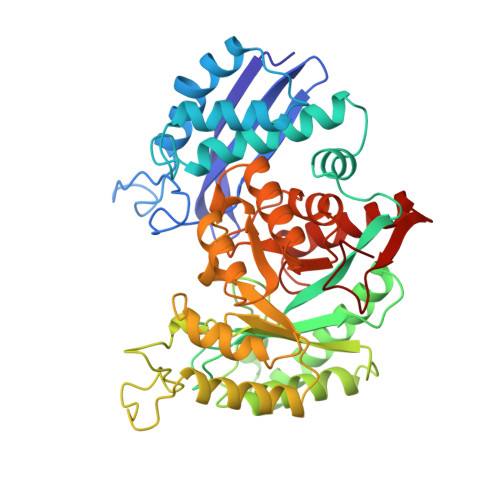Octahedral coordination at the high-affinity metal site in enolase: crystallographic analysis of the MgII--enzyme complex from yeast at 1.9 A resolution.
Wedekind, J.E., Reed, G.H., Rayment, I.(1995) Biochemistry 34: 4325-4330
- PubMed: 7703246
- DOI: https://doi.org/10.1021/bi00013a022
- Primary Citation of Related Structures:
1EBH - PubMed Abstract:
The structure of the Mg2+ complex of yeast enolase has been determined from crystals grown in solutions of poly(ethylene glycol) at pH 8.1. Crystals belong to the space group P2(1) and have unit cell dimensions a = 72.5 A, b = 73.2 A, c = 89.1 A, and beta = 104.4 degrees. There is one dimer in the asymmetric unit. The current crystallographic R-factor is 19.0% for all recorded data to 1.9 A resolution. The electron density indicates a hexacoordinate Mg2+ at the high-affinity cation binding site. The octahedral coordination sphere consists of a meridional arrangement of three carboxylate oxygens from the side chains of Asp 246, Asp 320, and Glu 295, and three well-ordered water molecules. Octahedral coordination is the preferred geometry for alkaline earth metal ions in complexes with oxygen donor groups. In previous crystallographic studies of enolase, Zn2+ and Mg2+ complexes at the high-affinity site were reported to exist in trigonal bipyramidal coordination. This geometry was suggested to enhance the electrophilicity of the metal ion and promote rapid ligand exchange [Lebioda, L., & Stec, B. (1989) J. Am. Chem. Soc. 111, 8511-8513]. The octahedral arrangement of carboxylate and water ligands in the MgII-enolase complex determined here is most consistent with reports of the Mn2+ and Mg2+ coordination complexes of mandelate racemase and muconate lactonizing enzyme. These latter enzymes have alpha/beta-barrel folds comparable to enolase.(ABSTRACT TRUNCATED AT 250 WORDS)
Organizational Affiliation:
Institute for Enzyme Research, Graduate School, University of Wisconsin, Madison 53705, USA.
















